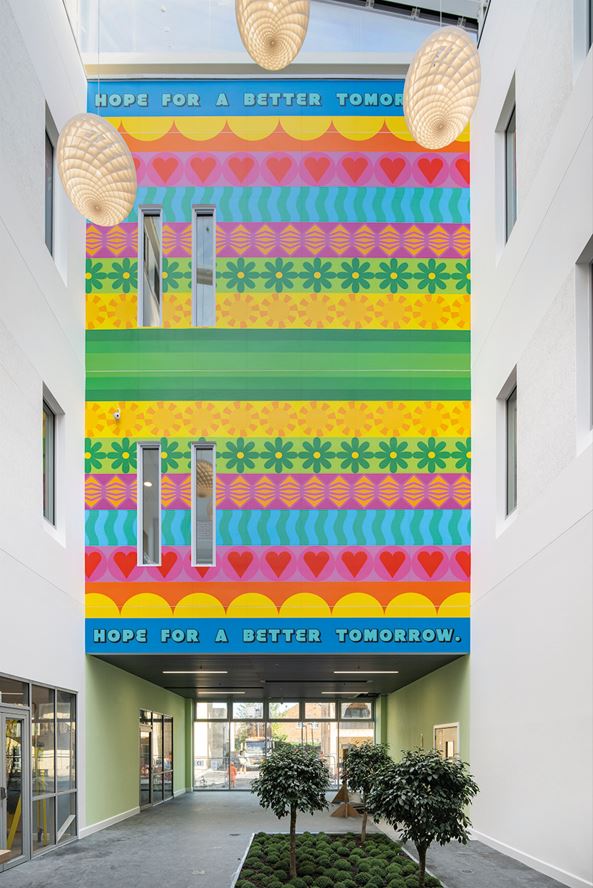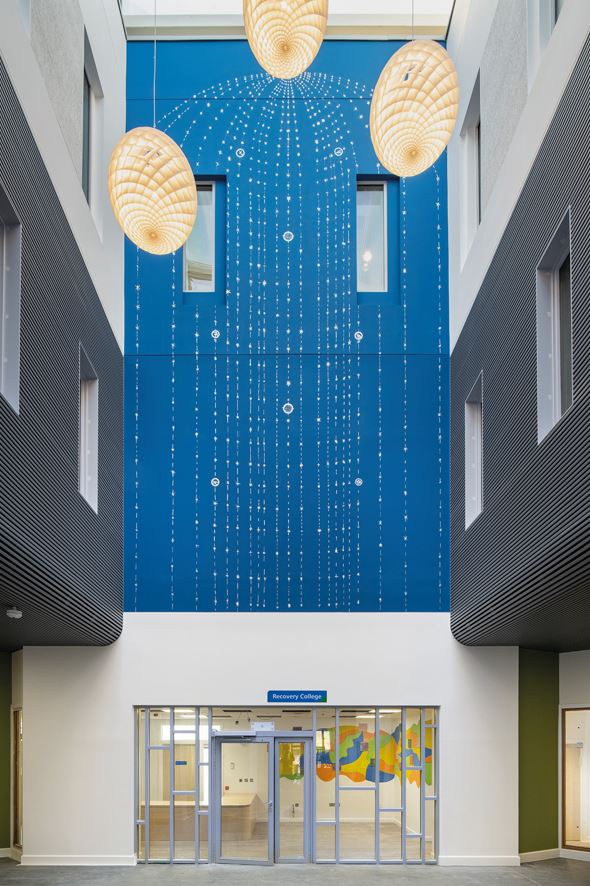
Transforming mental health spaces with hospital rooms
How environments look in mental health settings can have a profound effect on the wellbeing and recovery of someone experiencing mental health challenges. Artworks can encourage social interaction, bringing service users, staff and visitors together and offer a sense of belonging through a shared experience.
They can also provide an engaging environment that offers respite from the clinical atmosphere often associated with healthcare facilities. Hospital Rooms is a mental health and arts charity which attempts to transform the way these spaces are encountered through the form and content of the artworks they commission. They aim to encourage healing with artworks that inspire, empathise, respect and occasionally challenge.
AMBITIOUS PROJECT
In 2023, Hospital Rooms embarked on its most ambitious project to date in collaboration with South West London and St George’s Trust at Springfield University Hospital. This endeavour involved producing over 20 artworks across the hospital site, with the goal of redefining the experience of mental health facilities for both staff and service users. The project at Springfield University Hospital pushed the organisation to create its most ambitious artworks yet, working with over 20 artists and on scales they had never been able to realise before, sometimes installing artworks standing on mobile platforms more than 15 metres high, with vastly different media (from gold leaf, to fine art photographic prints, magnetised walls and ceramics). It’s a process that rewards them with new connections, friendships and community. Each artist brings a unique perspective, challenging conventions and fostering creative exploration within the hospital setting. Jasmin Sehra’s artworks, “Keep on Going” and “One Step at a Time,” emerged from workshops led by the British Sikh illustrator and artist, incorporating positive statements created by patients to inspire and empower one another. These murals serve as reminders to persevere through life’s challenges and embrace personal growth.
The project ushered in new collaborative ventures with local cultural organisations, including ActionSpace, The Courtauld, National Opera Studio, Share Community, and Studio Voltaire. Between 2021 and 2022, a plethora of workshops engaged both service users and staff across various departments within Springfield University Hospital, spanning inpatient wards, the Recovery College, and The Leon Kossoff Learning Centre at The Courtauld. A cornerstone of all Hospital Rooms endeavours involves partnering with artists who authentically represent the communities utilising mental health services. The initiative at Springfield University Hospital presented an opportunity to commission artworks that not only acknowledged the hospital’s ethnically diverse community but also instilled a sense of ownership among service users. Collaborating predominantly with ethnically diverse artists, the artworks produced were co-created with service users during these collaborative workshops. The overarching aspiration is for these efforts to catalyse a gradual shift in the entrenched hierarchies prevalent within mental health institutions, empowering those under care while fostering a more inclusive and participatory environment.
SPRINGFIELD COMMUNITY
This focus on representation further strengthened ties with specific services within the Springfield community. For instance, the partnership with Bluebell Ward, which caters to D/deaf individuals, relied heavily on the expertise of Rubbena Aurangzeb-Tariq, a deaf artist and therapist affiliated with Springfield University Hospital. Similarly, collaboration with Share Community, a day centre and community garden for individuals with learning disabilities, was enriched by the involvement of artist Linda Bell, supported by ActionSpace. Linda’s reputation as a notable figure in the London learning disabled community, along with her inclusive sensory art events, proved to be highly inspiring for participants. The ethos of Hospital Rooms centres on creating environments with and for the individuals who utilise them, emphasising collaboration and co-production. Insights gleaned from discussions and activities conducted in these sessions directly influenced the creation of each artwork installed within the hospital. Artists either integrated content and imagery generated from workshops into their proposals or drew inspiration from interactions with service users to shape the artwork’s final form.
CHRONIC HEALTH CONDITIONS
Mental health disorders are among the most prevalent and chronic health conditions in the world, yet societal acknowledgment and acceptance of these issues often lag behind. Hospital Rooms seeks to challenge this stigma through a combination of artwork, community engagement, and dialogue, aiming to redefine the landscape of mental health care. In tandem with these initiatives, consultation with a lived experience team (LET) played a pivotal role in guiding the project’s development. Formed in collaboration with Norwich University of the Arts (NUA) and Springfield University Hospital Recovery College, the LET endeavours to bolster the evidence supporting the integration of art in mental health care settings. Through innovative research methodologies such as collage, ‘photovoice,’ and ‘methods on the move’ (e.g., walking, mapping, and sketching), the LET facilitated opportunities for service users to share their experiences and perspectives on participation in the arts, as well as the transformative potential of art in in-patient and recovery spaces. “Hope For A Better Tomorrow - Lucky Charms”, a vibrant creation, blossomed from a series of workshops spearheaded by British Nigerian designer and artist, Yinka Ilori. Yinka orchestrated a chair painting session, beckoning participants to reimagine second-hand chairs using an array of vivid paints, fabrics, and ribbons.
Infused with Nigerian parables and patterns, patients delved into their narratives, expressing them through a kaleidoscope of colours, symbols, and motifs. Within the workshops, discussions veered towards the theme of hope, as participants shared sentiments of optimism and confidence in a brighter future beyond the confines of the ward. The mantra, “Hope for a Better Tomorrow,” emerged as a resounding declaration of aspiration within the artwork, serving as a beacon of positivity for all who traverse this space. As we set out the transformative potential of Springfield University Hospital, it’s crucial to outline a path towards uplifting mental health design. Embracing a set of design quality benchmarks, architects can align with NHS guidance to cultivate spaces that nurture both service users and staff. Key elements such as maximising daylight, fostering inside-outside connections, prioritising quietude, and integrating outdoor spaces are foundational. Additionally, the inclusion of gardens, cosy retreats, and diverse activity areas amplifies therapeutic potential while fostering comfort and engagement. By differentiating spaces and infusing them with art, we not only elevate the environment but also convey a message of care and community support. These initiatives, epitomised by the enriching works of Hospital Rooms, stand as a testament to the profound impact thoughtful design can have in instilling hope and resilience within mental health settings.
